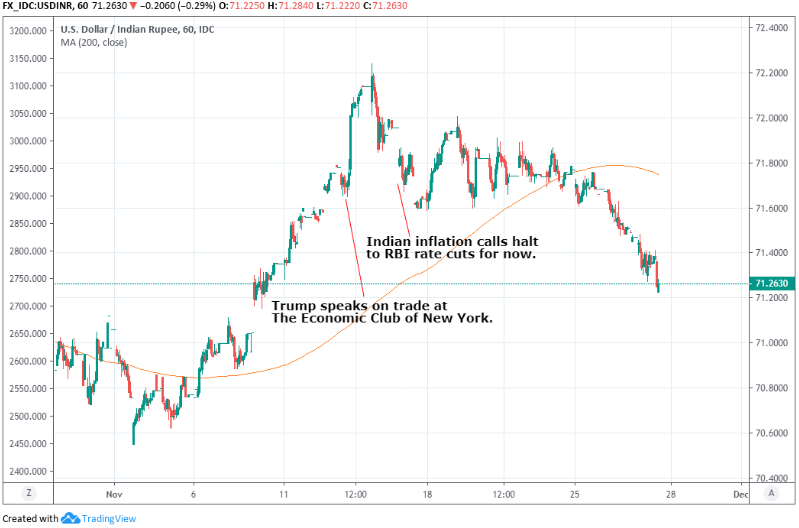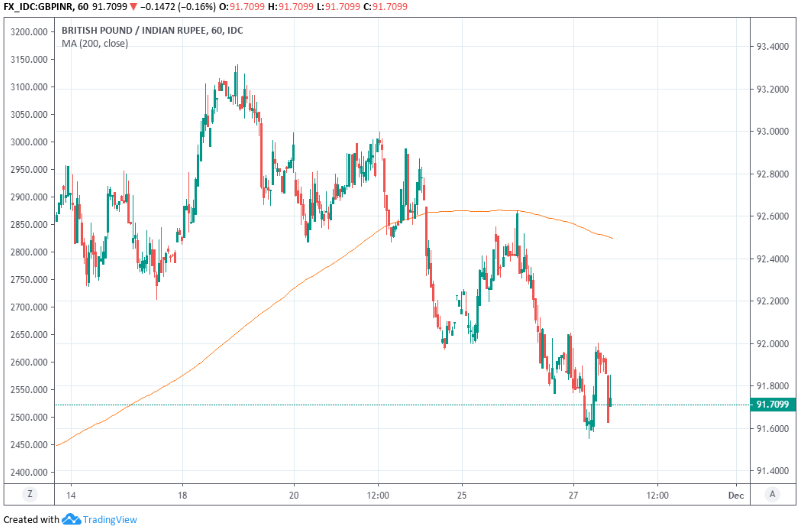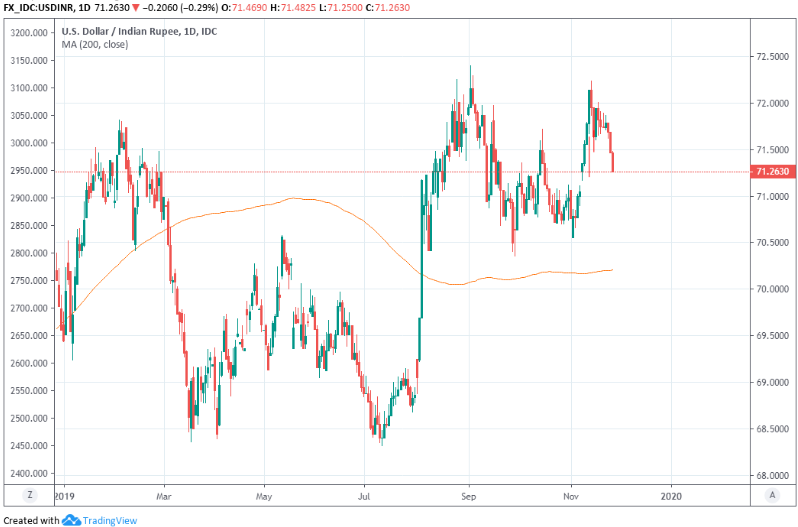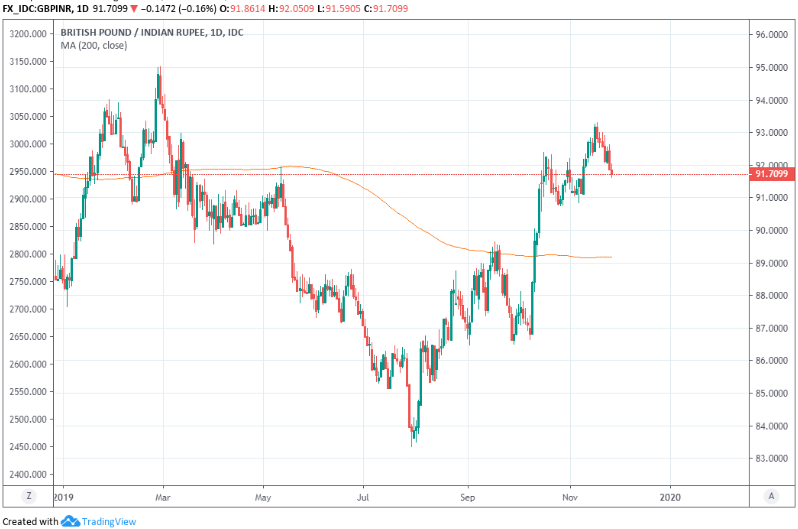Indian Rupee’s Depreciation Bias Has Returned, Analyst Says, and Charts Still Favour Losses
- Written by: James Skinner

Image © Adobe Images
- INR advances amid buoyant emerging markets.
- As U.S.-China trade deal optimism builds further.
- And U.S. growth surprises on the upside for Q3.
- But DBS Bank says INR depreciation bias is back.
- Looks for RBI rate cuts to push INR lower in 2020.
- As charts point to more gains ahead for GBP/INR.
The Rupee advanced on the Pound and Dollar Wednesday but its depreciation bias is alive and well, according to some analysts, and technical indicators on the charts warning of losses ahead for the Indian currency.
India’s Rupee shared in a broad upturn by emerging market currencies on Wednesday as investors celebrated this-time mutual claims from the U.S. and China of progress toward a ‘phase one deal’ that temporarily ends the trade war between the world’s two largest economies.
China’s Commerce Ministry said Tuesday Vice Premier Liu He spoke by phone with Treasury Secretary Steven Mnuchin and Trade Representative Robert Lighthizer. It says they “discussed how to resolve each other’s core concerns and reached consensus on how to resolve related issues.”
The acknowledgement came after President Donald Trump said negotiators are in the “final throes” of firming up the ‘phase one deal’ announced in October.

Above: USD/INR rate shown at hourly intervals.
Emerging market currencies and economies were hit hard hit by the trade war and resulting damage to the global manufacturing sector, not to mention the slowdown in China, so an end to the conflict would be positive for them.
“Many investors especially attribute the market’s rise to the Fed’s repo actions and the continued talks between China and the United States to reach a trade agreement,” says Christopher Dembik, head of macro analysis at Saxo Bank. “We even see more and more market participants talking about the potential for a rotation back to cyclicals and emerging market trades. However, in our view, short-term risks to growth remain and we would like to see a more clearly weakening USD before moving back to EM.”
The Rupee and other emerging market currencies were also aided on Wednesday by an economic data deluge from the U.S., which revealed that the world’s largest economy didn’t actually slow in the third-quarter as markets had been led to believe. In fact, the economy gathered a modest amount of momentum, with GDP growth rising from 2% to 2.1%.
Furthermore, the Federal Reserve Bank of Atlanta (Fed) GDPNow estimate of final quarter growth rose to an annualised 1.7%, up from 0.4% in the week ending November 19. That suggests there's still everything to play for as far the fourth quarter U.S. economy is concerned.

Above: Pound-to-Rupee rate shown at hourly intervals.
In short, the economy is in better condition than many had previously thought, which is good news for emerging markets as well as the broader global economy - especially as the Federal Reserve (Fed) is not expected to spoil any party by raising interest rates again at any point in the near future.
“We look for the Indian rupee to hold a 68.5-74.5 range with a weak bias. The Reserve Bank of India is expected to further lower rates by another 50bps by March 2020 after the total 110bps delivered since February. Conversely, the Fed is likely to have completed its mid-cycle adjustment after its third cut in October,” says Radhika Rao, an economist at DBS Bank.
The Rupee has enjoyed solid gains in recent weeks ever since inflation figures were seen to have tied the hands of the Reserve Bank of India (RBI) at least for the time being. The RBI has cut interest rates five times this year, with all the cuts coming under new governor Shaktikanta Das, a former government official who took over the RBI after the surprise resignation of Urjit Patel.
Inflation rose from 4% to 4.6% in October, taking it over the '4% plus-or-minus 2%' RBI target, after a sharp increase in food prices that month. The headline consumer price index is now at 16-month high after food prices paid by consumers increased 7.8% last month, although there could be larger increases than that in store on the road ahead.
“We expect headline inflation to taper over the next 6 months, during which low base effects will also keep inflation elevated (to recall January 2019 inflation stood at 2% YoY). Into FY21, trends are expected to moderate,” Rao says.

Above: USD/INR rate shown at daily intervals.
The Rupee gained support from the prospect of steady RBI rates and a buoyant stock market. And although others are still looking for it to rise next year as the global economy recovers, DBS is now tipping it for fresh depreciation because it sees more rate cuts coming from the RBI next year.
DBS says the Rupee will retain a downward bias so long as the USD/INR rate is above 70.50 and technical indicators on the charts are still pointing toward losses for Rupee relative to both the Dollar as well as Pound Sterling.
"92.364 is our pivot point. Our preference: the downside prevails as long as 92.364 is resistance," says Remy Gaussens, head of research at Trading Central, referring to the Pound-to-Rupee rate.
Gaussens says the intraday outlook favours a lower Pound-to-Rupee rate but on a multi-week basis, the exchange rate still has an upside bias and will liable to turn higher so long as the market is above the 89.52 pivot point that's not been seen since early October, before Prime Minister Boris Johnson agreed terms of the UK's exit from the EU and before President Donald Trump said he'd reached a 'phase one deal' to temporarily end the trade war with China.
"Our pivot point is at 89.523. Our preference: as long as 89.523 is support look for 98.001," Gaussens wrote in a note to Trading Central clients Wednesday. "The downside breakout of 89.523 would call for 86.482 and 84.672."

Above: Pound-to-Rupee rate shown at daily intervals.
Time to move your money? Get 3-5% more currency than your bank would offer by using the services of a foreign exchange specialist. A specialist payments provider can deliver you an exchange rate closer to the real market rate than your bank would, thereby saving you substantial quantities of currency. Find out more here.
* Advertisement
